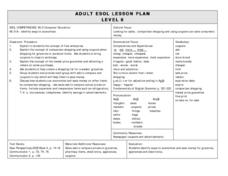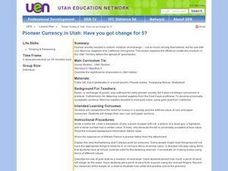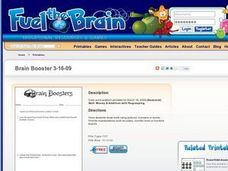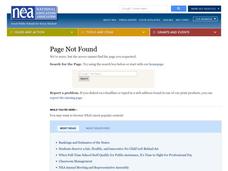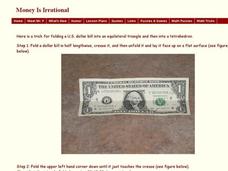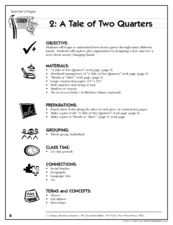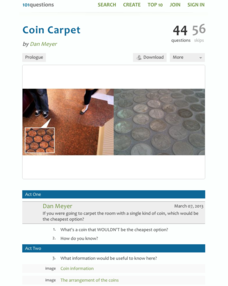Curated OER
Money
Second graders show combinations for $1.00. In this dollar combinations instructional activity, 2nd graders use nickels, dimes, and quarters to model and count combinations equaling $1.00.
Curated OER
Current Changes in Currency Design: Why A Newly Redesigned $50 Note?
Students examine United States currency with its new design. They discuss the reasons for the change. They also examine the impact this had on the economy as a whole.
Curated OER
Saving Money On Household Items
Students use sale ads to compare and contrast prices on groceries, electronics, appliances and other goods. Working in groups, students brainstorm ways to save money on these items. This lesson is intended for students acquiring English.
Curated OER
Vocabulary Lesson: Money Worksheet
For this money vocabulary worksheet, students answer 10 short answer questions about spending and saving money. Students must write about borrowing and lending money as part of this worksheet.
Curated OER
Money in Coins and Bills
In this money activity, 3rd graders show each money amount by using the smallest number of coins and bills. They mark the number of each coin and paper money amount from a list under the given amount.
Curated OER
Pioneer Currency in Utah: Have you got change for a 5?
Students explore the need for money in a society and the artificial value of coin and paper currencies. They design their own coin and paper currency.
Curated OER
Money Talks
Students move from fact finding to interpretation as they examine paper money from the time of the American Revolution. In the final exercise, they use the issue dates of the bills to construct a chronology of political changes during...
Curated OER
How Should Congress Allocate Money?
Students discover and examine how the government spends money and then determine what they this are priorities for national spending by illustrating their ideas on a pie chart. They research the national spending allocations on the...
Fuel the Brain
Brain Boosters-Money & Addition with Regrouping
If a leprechaun finds 39 cents, what are the possible coin combinations? A St. Patrick's Day math activity is a great way to keep the class excited about the holiday, but also keeps them focused on the math lesson too. By using addition...
Curated OER
Do You Really Need It?
Fourth graders read and share chapters of The Boxcar Children. In this wants and needs activity, 4th graders understand through their reading the differences between wants and needs. Students complete a worksheet about wants and needs...
Curated OER
Secret Agent Stan
Students answer time and money questions to solve a mystery. In this time and money lesson, students act as detectives to find Secret Agent Stan's identification number by answering questions from his logbook involving elapsed time and...
Curated OER
The Money Circle
Students investigate the Federal Reserve System. For this Mathematics/Economics lesson, students explore the role of the Federal Reserve in promoting a stable economic environment. In this multi-lesson unit of study, students explore...
Curated OER
Show Me the Money
Pupils investigate financial applications of mathematics in this mathematics lesson. They will investigate equations that represent a company’s income, expense, and profit functions and use those equations to identify break even points...
Curated OER
Money Is Irrational
In this geometry lesson, 10th graders fold a dollar bill to make a tetrahedron. They analyze geometric shapes and apply it hands on.
Houghton Mifflin Harcourt
Simple and Compound Interest
Your learners will get lots of practice calculating simple and compound interest by the end of this lesson. Simple explanations and examples lead learners through the concepts and steps of calculating simple and compound interest...
Curated OER
St. Patrick’s Day
Combine math, creative writing, and leprechauns in a fun St. Patrick's Day activity! Using a bag of gold coins and marshmallows, kids write a math story about a leprechaun that includes a multi-step equation to solve.
Federal Reserve Bank
Savvy Savers
What are the benefits and risks of saving in an interest-bearing account? Pupils explore concepts like risk-reward relationship and the rule of 72, as well as practice calculating compound interest, developing important personal finance...
Curated OER
A Tale of Two Quarters
Have your class use the life of a quarter to understand and design plot and flow charts. They read the book, The Go-Around Dollar, think about how their teacher got her quarters that day, then create a flow chart. They have to show how...
Curated OER
What Can We Learn about India from a Ten Rupee Bank Note?
The class finds and cites evidence showing India's unity in diversity and work to recognize some of the complex interactions of a civilized community. They read to understand how geography, history, politics, economics, beliefs, and...
Code.org
Looping and Simulation
Young computer scientists continue programming with while loops by creating a program to simulate coins flipping.
Council for Economic Education
A Penny Saved
A penny saved is a penny earned! Scholars research the different ways to save money over a lifetime. They investigate the Rule of 72, compound interest, and sub-prime loans to gain an understanding of how banks aid in the saving process....
iCivics
Emphasize Minimize
Encourage your class members to consider what points they are really emphasizing when they are making an argument, whether in writing or in speech. Watch out though, as this lesson may just leave your learners eager to debate you!
Advocates for Human Rights
Human Rights Defined
Class members continue their investigation of the factors that influence migration with a lesson plan on human rights. As they examine the Universal Declaration of Human Rights and selected US Constitutional Amendments, learners compare...
101 Questions
Coin Carpet
Here's a new meaning to the expression throwing away money...a carpet of coins! An intriguing lesson requires calculations to determine the coin that would be the cheapest option, but it's a little tricky. The cost of the coin changes,...
Other popular searches
- Money Lessons Giving Change
- Counting Money Lessons
- Canadian Money Lessons
- Second Grade Money Lessons
- 2nd Grade Money Lessons
- Australian Money Lessons
- Shopping Money Lessons
- Math Money Lessons
- Money Lessons Elementary
- Fun Money Lessons
- Counting Money Math Lessons
- Adding Money Amounts Lessons




